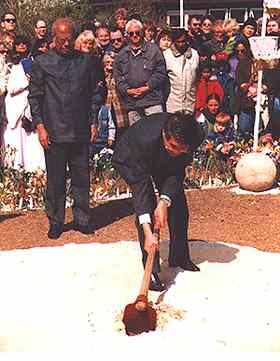| Forest Sangha Newsletter | October 1995 |
|
The Sima Ceremony In May of this year, three months before the Sima ceremony, we celebrated the Ground Breaking for the building of the new Temple at Amaravati in a very memorable ceremony. Hundreds of friends gathered to watch as the Sri Lankan and Thai Ambassadors took a hoe to the earth and removed the first bit of soil. It was a wonderful day that required much preparation and planning, and it left a strong feeling that the Temple will be for us all. |
|
Venerable Sirs, may the Sangha listen to me. |
|
By contrast, the Sima ceremony had to be timed to fit in with the digging of the temple foundations. Since we expected the ground of the site would be very uneven with gaping trenches, we felt that it would be hazardous to have too many people attending. We decided to conduct a simple ceremony, primarily for the Sangha.
Nonetheless, it felt very auspicious to have in attendance three of the most senior elders of the Theravada Sangha in Britain: Ven. Dr. Rewata Dhamma, Ven. Dr. Vajiragnnana, and Ven. Phra Kru Silananda. These three elders represent the Burmese, Sri Lankan and Thai Sanghas in Britain, and they have each been particularly helpful giving us guidance and support throughout our 18 years in Britain. It also worked out well that the Family Dhamma Camp was in mid-stride, so that at short notice, many could join in.
What Actually Happened? For the first part the Sangha gathered on each of seven squares to formally terminate any old agreement for a Sima to be located there. Though it is highly unlikely there could ever have been a Sima in Hertfordshire, we decided to add it in for good measure. All of the twenty-seven bhikkhus gathered on each square while two bhikkhus recited a Pali formula to relinquish the old Sima. Then they all moved onto each of the other six squares, and each time recited the formula. For the second stage, the main features were the eight spherical marker stones specially carved by Ken Grant, a stone mason and supporter of Harnham. (Ken's becoming a Sima expert after carving a set of 8 stones for the Harnham Vihara.) Monks, nuns and lay people all helped roll each stone into it's final position. Then Luang Por Sumedho and George Sharp went round to formally point out these stones, designating them as marking the north, northeast, east, etc. around the eight cardinal points. |
|
The third stage was the heart of the Sima ceremony. Here all the monks gathered together in the centre of the designated area and again two of them recited the formal motion and one announcement to say:
"Venerable Sirs, may the Sangha listen to me.
Venerable sirs, may the Sangha listen to me.
The Sangha has determined the boundary for a common communion and a single observance in accordance with these marks.
This completed the Bhikkhu Sangha's establishment of the Sima. By the end of the ceremony many of the children and parents from the Family Camp had gathered around and all joined in to chant the Karaniyametta sutta. |
 The ground is broken - at the centre of the new Temple site. |
|
An Historic Event Designating the Sima boundary was first introduced by the Lord Buddha as a means to encourage the unity and harmony of the Sangha. Simas could be large, including a whole monastery or even a village, and all the bhikkhus within that Sima would be obliged to hold their formal meetings together in the one place. A small Sima is often dedicated to one building. this would enable these Sangha acts to be easily carried out without being annulled by a passing bhikkhu turning up unexpectedly. In a year's time, when the Temple at Amaravati is hopefully complete, this new Sima boundary will be marked out on the floor inside. There, every fortnight, the Sangha will gather for the Uposatha recitation of the Patimokkha, as well as for the occasional Upasampada and Pabbajja ordination ceremonies. Throughout the 2500 years since the time of the Buddha, such ceremonies have always been an outward sign that the life of the Sangha continues. Here in the West, with the building of a temple and a Sima, it feels like the Sangha in Britain (and Europe) is flourishing and putting down roots. And in future this occasion may be seen as an historic event.
What's Next? And so, Ken Grant will soon be going to India, for he felt it would be particularly auspicious to have the ninth stone come from the land where the Buddha's teaching originated. |